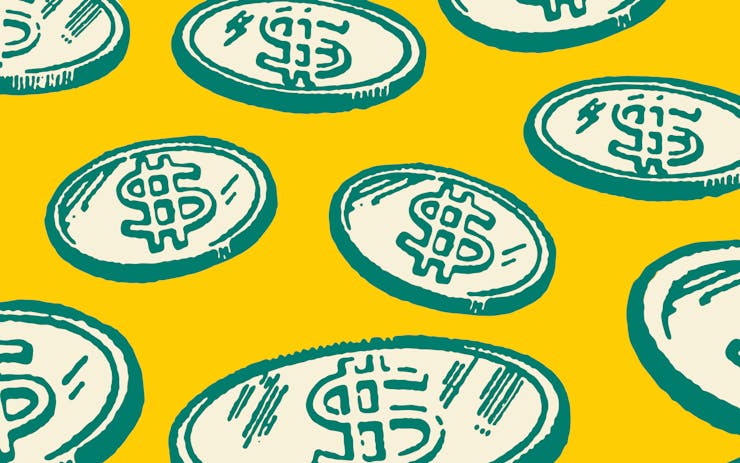The US’ 11th legalization state is also among its most seriously taxed.
Illinois’ first adult-use customers on Jan. 1 won’t be buying legal cannabis to save money, so much as to be a part of history. Prairie State recreational cannabis taxes average out to 26.25%, but the details are confusing as all get-out. At Leafly, we tried to parse it.
Here are Illinois’ direct and related adult-use cannabis taxes on launch day, based off the Illinois Cannabis Regulation and Tax Act.
6.75% state sales tax
Illinois’ 6.75% state sales tax applies to cannabis, creating the first direct cannabis tax consumers will see on their receipt at up to 55 initial stores that could be approved for recreational sales.
Purchaser taxes of 10-25%
This is where things get really confusing. Now we’re talking about two different types of percentages: price and THC, the main active ingredient in cannabis. Check it out.
10% purchaser tax on products less than 35% THC
Buy a joint, pay 10%. Pretty much all flower is made up of less than 35% THC by dry weight, so they get taxed at this base rate.
20% purchaser tax for cannabis-infused products up to 35% THC
Buy a pot cookie? That’s a 20% purchaser tax. Cannabis-infused products means any food or drink with cannabis in it, and most are lower than 35% THC by weight.
25% purchaser tax on products exceeding 35% THC
Buy some awesome hash in Illinois—that’s a 25% purchaser tax. This tiered THC structure could deter use of more potent formulations, and it’s becoming more common in the US.
Looking for Illinois dispensaries? Leafly Finder locates one near you
Local taxes of up to 3.75%
Lastly, the local city or county gets a cut—up to 3.75% if your store is in an unincorporated area of a county, or 3% in a city proper. Most jurisdictions have local bans in Illinois. Those that don’t promise to tax to the max.
Medical cannabis patient discount
Illinois’ nearly 100,000-strong patient-base will enjoy tax reductions. Their state sale tax rate is just 1% and they don’t pay purchaser taxes.
So what’s a typical receipt going to look like?
Say you bought $100 worth of flower and edibles. Expect to pay $132.25 out the door at Sunnyside dispensary in Chicago, Jan. 1, after 6 a.m. For medical patients, $104.75.
Other taxes you don’t see—cultivation, federal
7% Illinois cultivation tax
You won’t see this on your receipt, but you can bet it’s being passed down from the grower. All cannabis is taxed 7% at the farm gate, and the farmer does not eat the loss—they raise their prices.
Federal income tax
In the eyes of the Internal Revenue Service, licensed Illinois cannabis businesses are considered drug dealers, and thus disallowed from taking ordinary and necessary deductions for business costs. IRS section 280e amounts to a 70% income tax on cannabis businesses according to estimates from the National Cannabis Industry Association.
That most certainly raises the cost of doing business, and thus the price of legal cannabis in Illinois, thereby lengthening the lifespan of the illicit market. Several federal bills including the STATES Act, and MORE Act could pare back these onerous levies.
Taken together, these taxes paint a burdensome picture of a market severely hampered in its ability to compete with the street. Illinois has a robust illicit market culture that includes online sales, couriers, and pop-up parties every day in Chicago, said Danielle Schumacher, a diversity and inclusion recruiting consultant based in Illinois. “It’s major—there’s such a thriving underground.”
The people who can afford to pay for legal cannabis will enjoy the privilege of doing so, she said. Many others, not so much.
Where does that money go?
Illinois could collect $400-$600 million in annual taxes when the industry is mature. That tax money, as well as licensing fees, will pay for cannabis regulations and social welfare projects.
The Department of Revenue uses tax revenue to pay for the direct and indirect costs of the Cannabis Regulation and Tax Act, which covers functions across several Illinois state departments.
Of the remainder, 1/12th goes into a Cannabis Expungement Fund to pay the state’s costs of clearing old records.
Of the remainder of that:
- 2% goes to the Drug Treatment Fund
- 8% to the Local Government Distributive Fund
- 25% to the Criminal Justice Information Projects Fund
- 20% to the Department of Human Services Community Services Fund
- 10% to the Budget Stabilization Fund
- 35%, or the remaining balance, to the General Revenue Fund
Each of these funds tackles different aspects of restoring justice after the end of the war on cannabis.
For example, the 25% Criminal Justice allocation goes to a program dubbed Restore, Reinvest, Renew (R3), good for tens of millions of dollars in grants to community groups to decrease gun violence and concentrated poverty.
The Illinois legislature has the power to review as adjust tax rates as needed.





